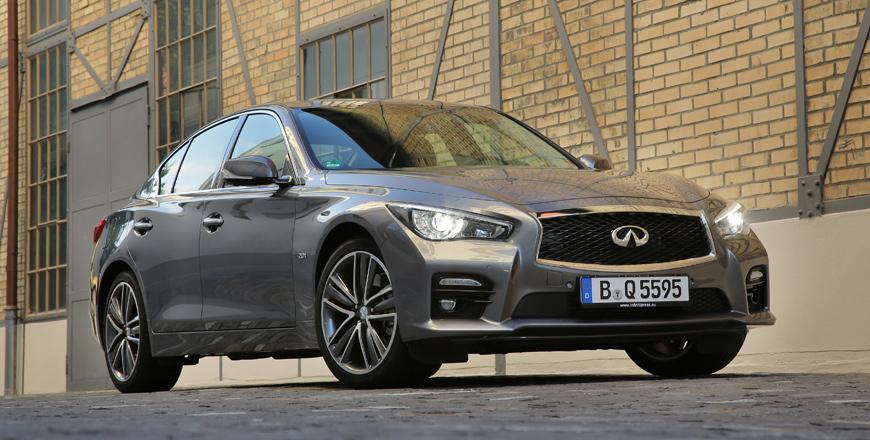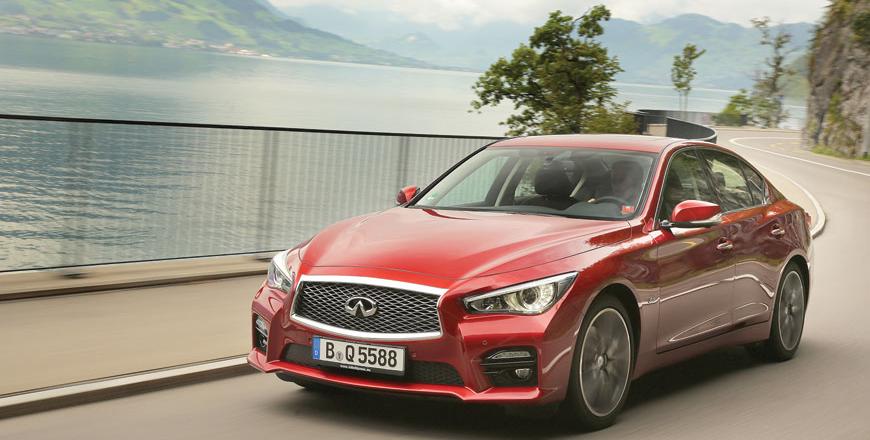You are here
Infiniti Q50 2.0t: Swooping, spacious sports saloon
By Ghaith Madadha - Aug 13,2018 - Last updated at Aug 13,2018

Photo courtesy of Infiniti
First launched in 2013 with the featured entry-level 2.0t model arriving the following year, the Infiniti Q50 is the Honk Kong-based Japanese manufacturer’s compact executive saloon follow-up to the fondly remembered and superb yet sometimes underrated G-Sedan.
Ushering in a new “Q” based alphanumeric nomenclature and the first production car ever offered with optional drive-by-wire steering, the Q50 was and remains a bona fide rival the likes of the BMW 3-Series, Mercedes C-class and Audi A4 that well stands the test of time even against newer German rivals, and other competitors.
Assertive, aerodynamic aesthetic
Among the prettier, yet more assertively designed cars in its class, the Q50’s sculpted surfacing, flowing lines, complex ridges and moody demeanour are nevertheless sophisticated and stylish. A natural successor to G-Sedan’s urgent posture, the Q50’s styling is fluent and evolutionary, rather than being an overstated departure from previous design, as is the case with its closest Japanese rival.
Assertively muscular, yet smoothly flowing, the Q50’s design further provides low CD0.26 aerodynamics and zero lift, which contribute to its quiet ride and stability at speed, and improved efficiency.
With a long swooping and ridged bonnet, rearwards cabin and pert boot emphasising its classic front-engine and rear-wheel-drive layout, the Q50’s rakish roofline, prominent haunches and rear window kink help complete a sense of forward momentum and assertive road stance.
Dramatic from front, the Q50 features a snouty and wide honeycomb grille that is pinched in the middle, and flanked by heavily browed headlights. At the rear, it features prominent dual tailpipes and a built-in boot ridge that serves as a spoiler. Meanwhile, mildly revised version is expected to arrive in Jordan by next year, with minor styling differences.
Robust and responsive
The entry-level petrol model in a wider Q50 range that features two 3-litre twin-turbo V6 engines replacing Infiniti’s sublime traditional naturally-aspirated 3.7-litre V6, and a 3.5-litre hybrid, the turbocharged direct injection 2-litre four-cylinder 2.0t driven is, however, no slouch, and offers confidently brisk performance.
Sourced from Mercedes-Benz under a technology-sharing deal, the Q50 2.0t’s engine is the equivalent to Mercedes’ own “250” engine designation. Developing 208BHP at 5500rpm and 258lb/ft throughout 1250-3500rpm, the Q50 2.0t dashes through 0-100km/h in 7.2-seconds and tops out at 245km/h, yet returns moderate 6.3l/100km combined cycle fuel consumption.
Well suited for city, highway and more interesting winding and steeply inclining country routes, the Q50 2.0t’s quick spooling turbo ensures good responses in traffic and hill starts.
Meanwhile, its generous and robust mid-range torque sweet spot provided on the move flexibility and confidence during test drive in Amman and more hilly terrain further afield. Smooth and consistent in delivery, the Q50’s low rev gurgle lends an impression of latent yet un-tapped power when cruising. However, and unlike Infiniti’s naturally-aspirated V6 engines, the 2.0t is comparatively low-revving and does its best work in mid-range, up to 5500rpm.
Sporty set-up
Smooth, stable and refined at speed and in town, the Q50 is also comfortable and forgiving in town, albeit with a slight firmness on small jagged bumps, owing to the use of run-flat tyres with firm sidewalls. At 225/55R17 tyre size is just right for aesthetics, handling, braking, steering, efficiency and comfort over imperfect Jordanian country and city roads.
On crests and dips, vertical control is meanwhile settled and rebound is nice and taut, while braking on steep descents and from speed was reassuring and well resistant to brake fade.
Lighter in front than other Q50 models, the 2.0t is tidy and eager turning into corners, with front tyres gripping well and its electric-assisted hydraulic steering providing quick and accurate reflexes and a more natural feel for the road and the car’s position than the more exotic drive-by-wire system offered on some Q50 models.
Set-up with sporty and drift-bias that is counteracted by its stability controls keeping things in order if one gets too enthusiastic. In low intervention “off” mode, stability controls allow more leeway for one to easily slide the rear out slightly and to self-correct before it steps in.
Eager and ergonomic
With its eager and agile cornering aided by a selective braking torque vectoring system, the Q50 carves corners eagerly and tidily. And while stiffer damping and more mechanical rear grip might have been welcome on some low traction road surfaces, the Q50 drifty and pointy handling are entertaining and help one tighten cornering lines with an easily induced, but balanced and predictable weight pivot.
For best result through winding roads, the Q50 responds well to a committed yet measured driving style and smooth progressive inputs, including steering turn-in and when coming back on throttle after a corner’s apex to strike a balance between cornering grip and adjustability.
At the sportier handling end among compact executive saloons, the Q50 is a sometimes overlooked but formidable player in its segment. No one-trick pony, it also offers a comfortable and refined ride. Its pleasantly airy, leather-bound and well-appointed cabin is among the most spacious in the segment, especially compared to some other “first time”compact executives, while generous 500-litre volume even outdoes some full-size luxury saloons two segments above.
Ergonomic inside with a comfortable, supportive and well-adjustable driving position, the Q50 is also well-equipped and features reversing camera, parking sensors, dual screen infotainment system, dual-zone A/C and more, as driven.
TECHNICAL SPECIFICATIONS
Engine: 2-litre, in-line, turbocharged 4-cylinders
Bore x stroke: 83 x 92mm
Compression: 9.8:1
Valve-train: 16-valve, DOHC, direct injection
Gearbox: 7-speed automatic, rear-wheel-drive
Power, BHP (PS) [kW]: 208 (211) 155 @5500rpm
Specific power: 104.5BHP/litre
Power-to-weight: 121.28BHP/tonne
Torque, lb/ft (Nm): 258 (350) @1250-3500rpm
Specific torque: 175.79Nm/litre
Torque-to-weight: 204.08Nm/litre
0-100km/h: 7.2-seconds
Top speed: 245km/h
Fuel consumption, urban/extra-urban/combined:
8.6/5/6.3 litres/100km
CO2 emissions, combined: 146g/km
Fuel capacity: 80-litres
Height: 1,445mm
Width: 1,820mm
Length: 4,790mm
Wheelbase: 2,850mm
Track, F/R: 1,540/1,570mm
Aerodynamic drag co-efficient: 0.26
Kerb weight: 1,715kg
Luggage volume: 500-litres
Steering: Electric-assisted rack & pinion
Turning diameter: 11.4-metres
Suspension, F/R: Double wishbones/multi-link, twin
tube dampers, stabiliser bars
Brakes, F/R: Ventilated discs, 330mm/308mm
Tyres: 225/55R17
Price, as tested: JD48,800 on-the-road, no insurance
Related Articles
The first car bearing Infiniti’s new “Q”-based nomenclature, the Q50 first launched in 2013 as the world’s first car with advanced steer-by-
Innovatively high-tech yet viscerally connected, the Infiniti Q50 first appeared as 2014 model year sports saloon successor to the acc
A high-tech replacement for the Infiniti G Sedan, the new Q50 compact premium saloon is the luxury brand’s first new offering since recently relocating to Hong Kong and reasserting itself as a global and urbane sports luxury brand.


















